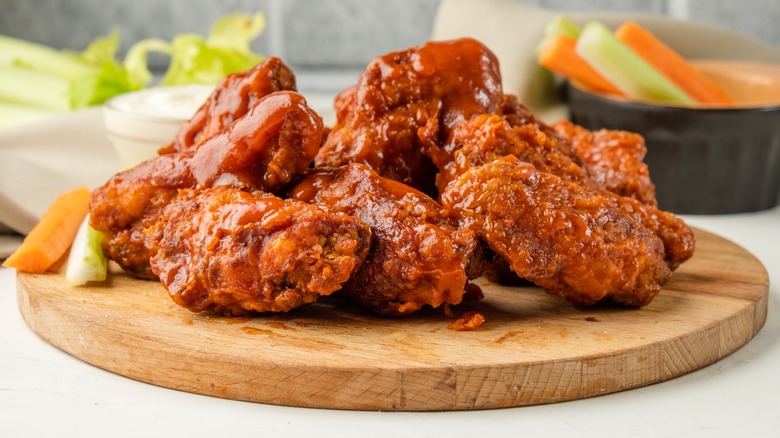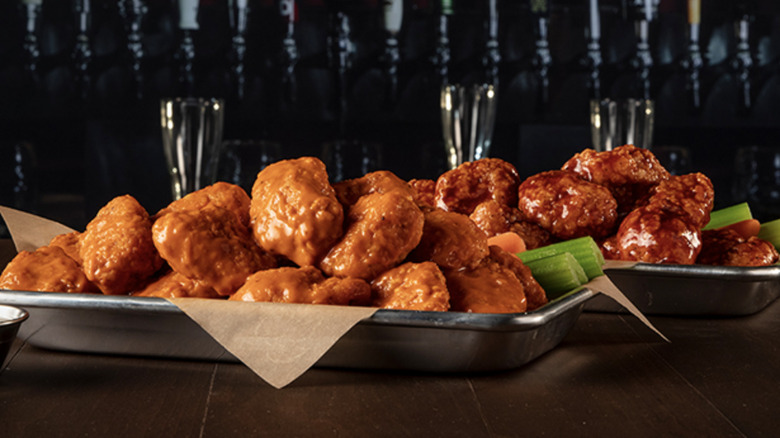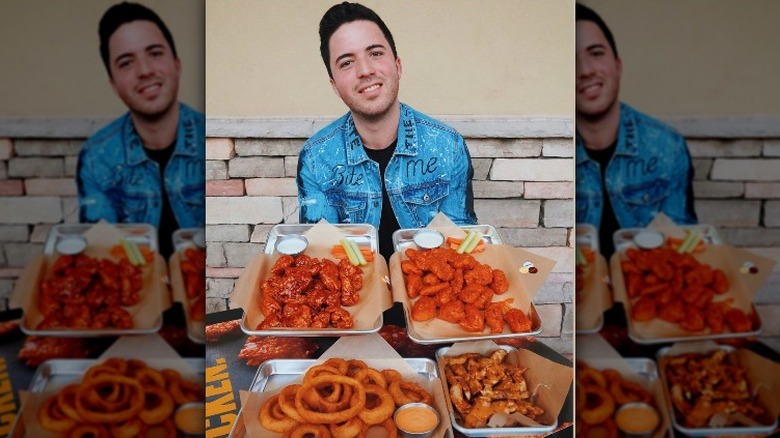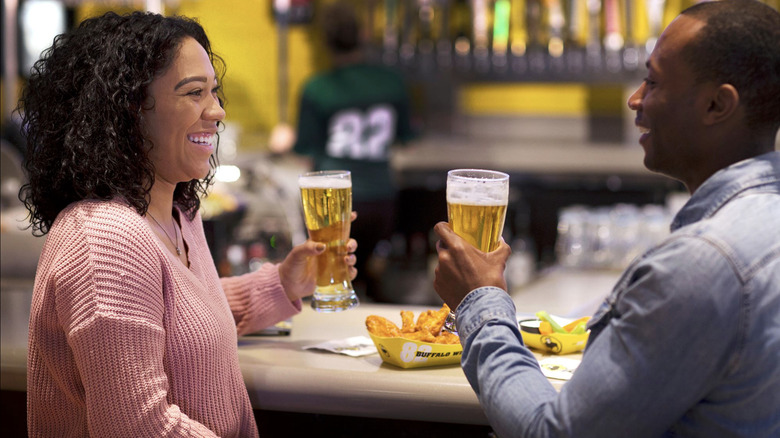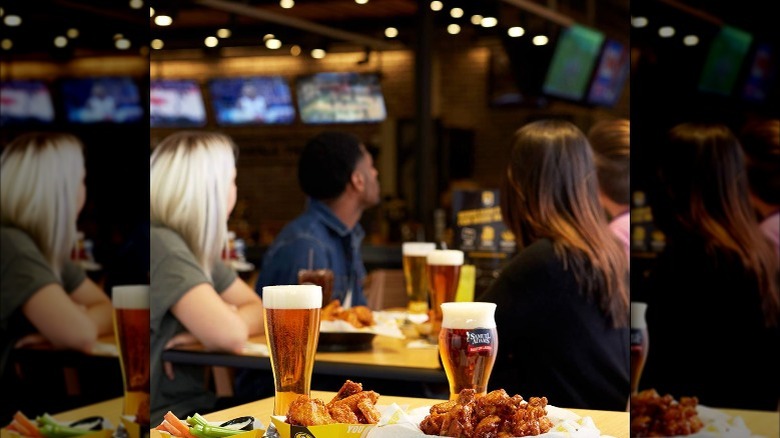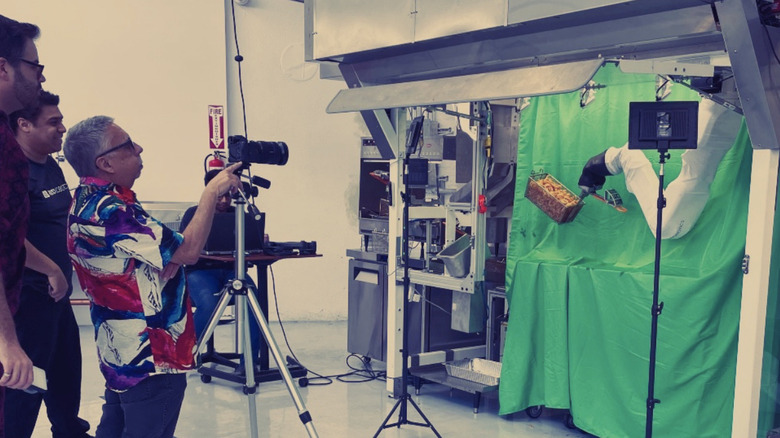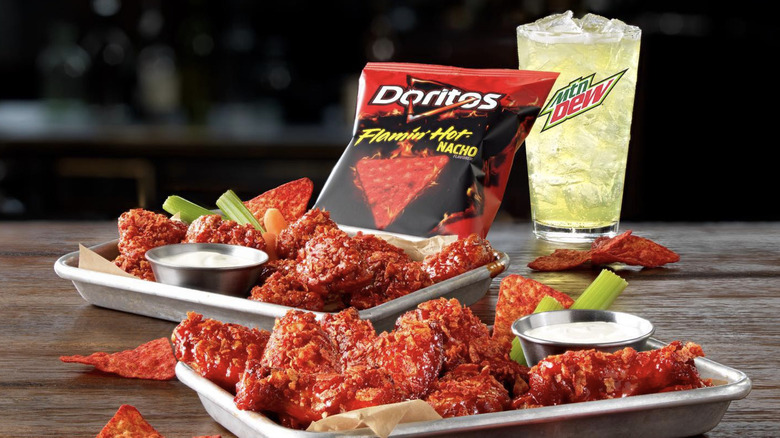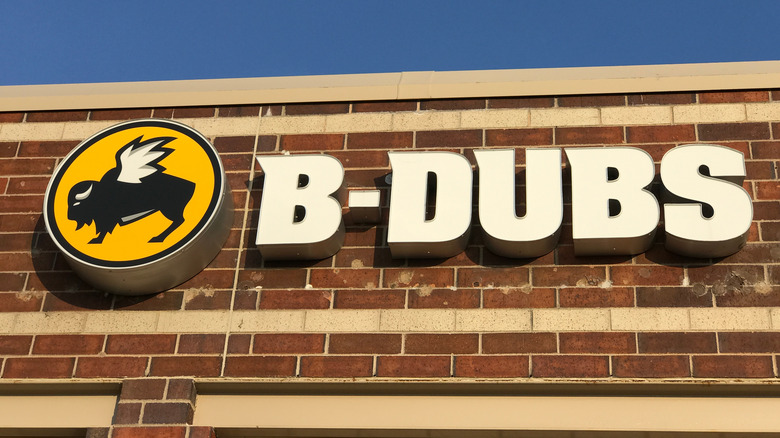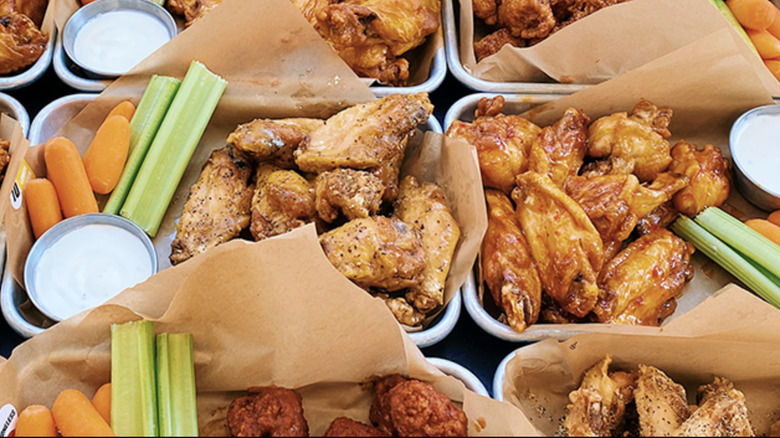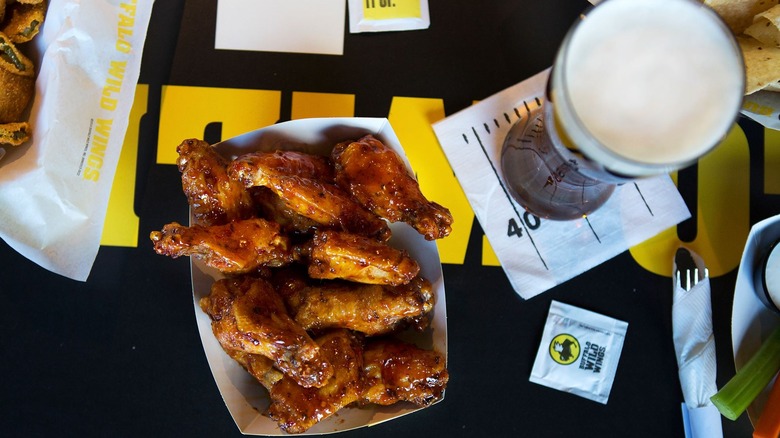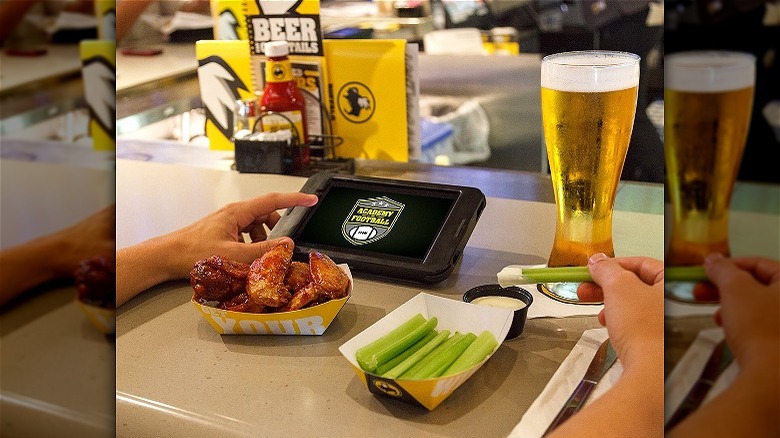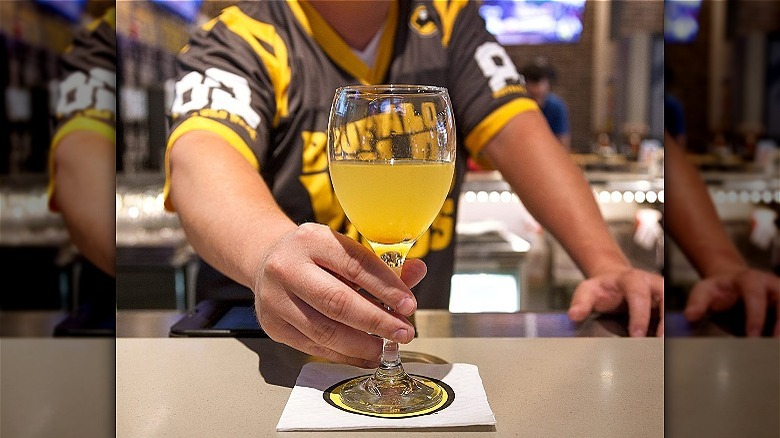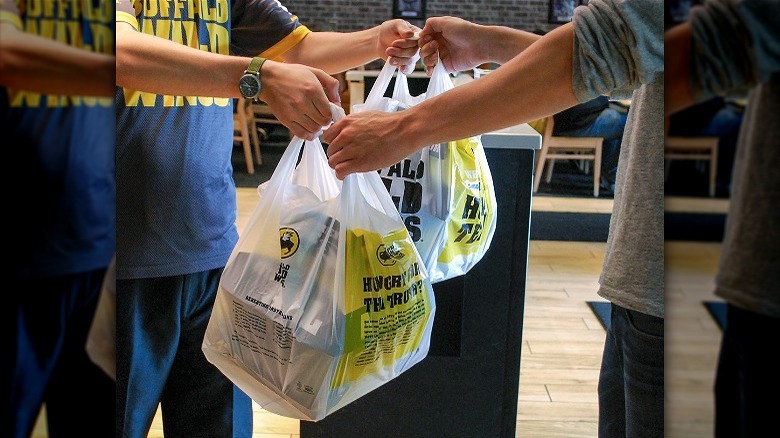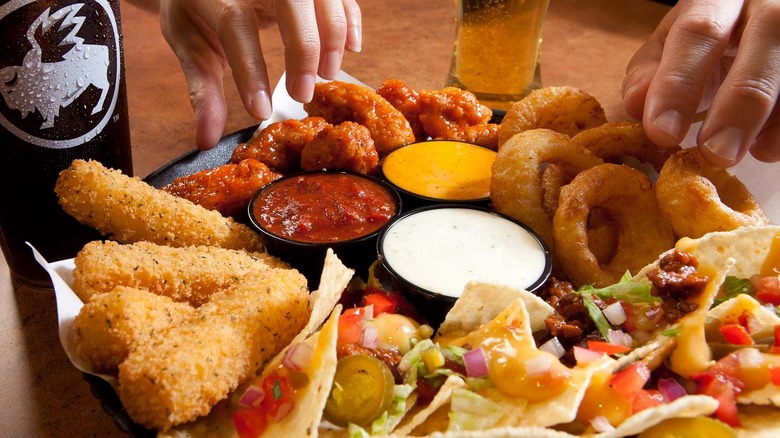We Finally Know Why Buffalo Wild Wings Is So Cheap
With the tagline "Wings. Beer. Sports.," Buffalo Wild Wings is abundantly clear about its marketing concept. And the franchise delivers on its promise. Not only is Buffalo Wild Wings the largest sports bar brand in the States, but the chain also serves a lot of wings and beer, says Buffalo Wild Wings. Not a bad marketing ploy considering that Americans were projected to indulge in 1.4 billion chicken wings on the 2022 Super Bowl LVI weekend alone (via National Chicken Council).
Founded in 1982 in Columbus, Ohio as Buffalo Wild Wings & Weck, today the chain boasts a new name and more than 1,200 restaurants across 10 countries, per Buffalo Wild Wings. Often called B-Dubs or BW3 — a reference to the Weck that appeared in its original name — Buffalo Wild Wings in August 2017 invested in a fast service version of its traditional restaurant: the B-Dubs Express. Aimed at millennials and those who like to eat on the go, the spinoff restaurant aims to offset the dip in the casual dining industry (via Media Group Online). This, however, isn't the chain's only strategy for success. Keep reading to find out how Buffalo Wild Wings has managed to stay so popular and maintain its competitive prices.
Buffalo Wild Wings sells a lot of boneless wings
While boneless chicken wings might taste like their traditional counterparts, they don't come from the same part of the bird. The fact is that boneless wings have very little to do with wings. They are chicken breasts cut into wing-sized pieces. Russ Whitman, a Poultry Analyst at Urner Barry, explained how boneless wings are made, saying, "what they do is they take a piece of breast meat, and they essentially strip it down, cut it into five three-inch long pieces ... and throw it in a fryer" (via The Counter).
Buffalo Wild Wings began selling boneless wings back in 2003 to deal with the increasing prices of bone-in wings caused by both high demand and production costs (via Restaurant Business Online). There's another reason why traditional wings tend to be more expensive than boneless wings. While you only get four wing pieces per bird — two flats and two drumettes — each chicken breast can be cut into multiple "wings" (via NRN).
In his article for FoodBeast, Constantine Spyrou refers to boneless wings as "glorified chicken nuggets." However, he also points out that chains such as BW3 don't want to call them that for a very particular reason. "When you think of wings, you think of beer, sports, bars, watching a game, and having a good time with friends," he writes. "When you think about chicken nuggets, however, the image is more along the lines of fast food."
Buffalo Wild Wings replaced its half-price wing deal with a boneless wing promo
To deal with the soaring wing prices, in 2017 Buffalo Wild Wings replaced its Half-Price Wing Tuesdays with Boneless Thursdays. The shift took place across both company and franchise outlets, per NRN. While Half-Price Wing Tuesdays brought a lot of customers to the restaurant, the deal ended up cutting into the chain's margins due to high wing costs. Particularly since the price of chicken wings rose from an average of $1.72 per pound in 2016 to $2.16 per pound in 2017, via Business Insider.
Former Buffalo Wild Wings COO James M. Schmidt said in 2016 that he was optimistic about the shift to Boneless Thursdays since the chain's boneless wings outsold bone-in wings, according to Business Insider. The shift worked, with Buffalo Wild Wings' profits and shares soaring in the third quarter of 2017. While the scheme has worked, Buffalo Wild Wings eventually brought back its Tuesday deal, albeit in a slightly different format. Now, when you buy traditional wings on Tuesday, you can get another set of wings at 50% off, per Buffalo Wild Wings.
Buffalo Wild Wings sells a lot of beer
Wings and beer go together like peanut butter and jelly, or so some say. They also go well with sports, something BW3 uses heavily as a part of its marketing strategy. As such, it's not surprising that aside from food, the chain is also focused on selling beer. In fact, BW3 took the title of the largest pourer of draft beer in the U.S. in 2020 (via FSR Magazine). The chain's Director of Beverage Strategy and Innovation, Jason Murphy, explains, "At Buffalo Wild Wings, our goal is to create a balanced lineup of beers from local, regional, and national breweries, representing craft, import, and domestic and a broad range of styles that appeals to all beer fans." (via Inspire Stories).
According to Motley Fool, alcoholic beverage sales make up around 20% of BW3's revenue — in other words, a very respectable sum. And with over 30 beers on tap, including Budweiser, Guinness, and Heineken, the franchise definitely takes its brews seriously. There are also more unusual house beers such as the Wild Herd Kölsch by Goose Island, which was added to the menu in 2020.
Buffalo Wild Wings uses sports to bring in customers
Unlike some other popular chains, Buffalo Wild Wings traditionally hasn't based its revenue model on having customers leave the restaurant as fast as they enter. The franchise's business strategy assumes that having guests snack on wings and drink beer throughout an entire football game is bound to pad bills delivered to customers (via Fortune). And the chain's restaurants are designed to promote just that. The outlets are fitted with stadium-like audio-visual technology, modular screens, and comfortable seating. Features like these make outlets ideal spots to watch sports or just hang out (via Buffalo Wild Wings Franchising).
Buffalo Wild Wings is also hoping to increase its revenue by promoting betting in the states where this is legal. In March 2021, the chain partnered with BetMGM to make this possible. Rather than investing in betting terminals, however, the duo kicked the initiative off with a free-to-play game on the Buffalo Wild Wings Blazin' Rewards app called Picks & Props. And while the game can be played anywhere, the prizes can only be claimed at Buffalo Wild Wings restaurants (via Action Network).
Buffalo Wild Wings has a robotic chicken wing fryer
To address labor shortages, and no doubt save on labor costs, Buffalo Wild Wings is getting ready to introduce a new addition to its team in 2022 — Flippy Wings, the robotic wing fryer. The result of a partnership between the chain's parent company Inspire Brands and Miso Robotics, Flippy Wings — or Wingy for short — will streamline operations and maximize efficiency. According to the robot's creators, Wingy can increase the speed of food production by between 10% and 20% (via 1851 Franchise).
According to a press release, Flippy Wings comes with AutoBins where kitchen staff drop products to be cooked. The AI system then picks up the food, cooks it, and places it in a holding area. The CEO of Miso Robotics, Mike Bell, explained the benefits of the venture, saying, "Flippy Wings fries fresh, frozen or hand-breaded products like a pro, avoiding cross contamination and increasing throughput while reducing costs. It is fast, safer to operate than traditional fryers and the whole system can be set up in just a few hours over existing equipment."
Buffalo Wild Wings isn't the only restaurant eager to utilize robotics in its food processing system. According to the 2021 Global State of Hospitality Report, 45% of restaurant operators have said that they plan to use automation technology during the next two to three years.
Buffalo Wild Wings attracts customers with innovative menu options
Unlike its name suggests, Buffalo Wild Wings is about much more than just chicken wings — the restaurant also serves burgers, wraps, greens, desserts, and a huge variety of drinks and side sauces. In fact, the chain continuously updates its menu to keep its current customers happy, and to attract new ones. One of Buffalo Wild Wings' latest offerings is the MTN DEW Legend. Released in 2022, the beverage blends MTN DEW with blackberry, ginger, and citrus (via CISION PR Newswire). Another example of BW3's relatively recent menu addition is the All-American Cheeseburger. Introduced in 2019, the burger comes with two beef patties, cheese, lettuce, tomatoes, pickles, and a Challah bun (via Buffalo Wild Wings).
Aside from new menu items, Buffalo Wild Wings regularly debuts new limited-time sauce additions to its lineup of condiments. Perhaps one of the franchise's most imaginative limited-edition sauce offerings was the Doritos Spicy Sweet Chili Flavored Sauce, which combined the flavors of soy sauce, garlic, paprika, onion, and brown sugar.
Buffalo Wild Wings is investing in B-Dubs Express
In 2017, Buffalo Wild Wings embraced a new business model with the opening of the first B-Dubs Express in Edina, Minnesota. Unlike the traditional Buffalo Wild Wings restaurants, B-Dubs Express outlets don't require customers to wait to be seated and deal with servers. Focused on take-out, B-Dubs Express locations also feature fewer television screens than traditional Buffalo Wild Wings restaurants and seating for only around 35 to 50 patrons (via Media Group Online).
The main goal of the new strategy has been to attract millennials and reduce the chain's need for staff by adopting a scaled-down, grab-and-go approach. Customers who visit B-Dubs Express can order right at the counter and either take their food home or sit down — a fast food casual dining approach that seems to be appealing to millennial customers. Former Buffalo Wild Wings CEO, Sally Smith, noted that millennial consumers were more likely than older consumers to eat at home, have food delivered from restaurants, and have quick meals at fast-casual or quick-serve restaurants.
Buffalo Wild Wings' food isn't cooked fresh
Just like many other fast food franchises that are cost-savvy, Buffalo Wild Wings has a lot of its food arrive at the restaurant either frozen or pre-packaged. According to a Reddit member who claims to be a cook for the chain, this includes menu items such as burgers, boneless wings, and salads. According to the employee, the only menu items that aren't ever frozen are wings and produce. However, the Reddit member also adds that they would avoid ordering wings between 3 and 5 p.m. since this is the "slow time" when they tend to sit in the holding area for longer (via Reddit). According to Business Insider, Buffalo Wild Wings shifted from serving frozen to fresh beef in 2019.
So what about BW3's food preparation? While it's highly unlikely that you'll find the odd chicken head amid your wings, a few of the chain's food items do get microwaved. A self-proclaimed Buffalo Wild Wings manager once came clean about the chain's cooking practices on Reddit, saying, "we microwave diced chicken which goes into the grilled wraps and buffalitos ... Our spinach artichoke dip is microwaved per order for freshness standards. We also microwave cheese onto buffalo chip or wedges, but those are made fresh per order."
Wings are served by quantity, not volume
For a hot minute, wings from Buffalo Wild Wings were sold in sizes small, medium, or large. Slinging them by volume, it turns out, was actually more expensive for BW3 in the long run. In 2020, Restaurant Business reported that the chain switched to ordering by quantity on the grounds that the former method drove up food costs.
As former CEO Sally Smith explained to Restaurant Business, employees would go through a lot of wings to fit the specific weight requirements for each portion. Wings don't come in consistent shapes or sizes, nor can they be sliced up because of the bones, so workers would have to include more, not less, to meet the target. Keeping in mind that BW3 procures its meat by the pound, the excess amounts added up fast. And from the customer's perspective, it blurred the lines of exactly how much food they could expect to get in return (per Restaurant Business).
Today, customers can order wings in batches of six, 10, 15, 20, and 30 (per Buffalo Wild Wings). The count-based approach is easier for both parties involved, because customers will know what they're paying for upfront and the chain can budget accordingly since there's no guesswork in estimating how much product they'll have to purchase. This helps Buffalo Wild Wings' top specialty — the wings — remain as affordable as they are. We imagine tailgate parties got easier to plan with the decision.
Buffalo Wild Wings has embraced automation across its restaurants
Restaurants like Buffalo Wild Wings flourish because there's a strong foundation in place for the business to run smoothly. Point-of-sales, or POS, technology has been implemented by the chain for years, and it's produced fruitful profits while reducing unnecessary costs. Virginia-based franchises, for example, experienced increased productivity after implementing the 24-7 Hospitality Technology system, which provided around-the-clock tech assistance and software for streamlining menus across locations (via FSR Magazine).
QSR Automations is the latest technology BW3's taken under its wing, as reported once again by FSR Magazine, and it's been called "an all-around win" by VP of Restaurant Technology Chuck Eicher. The software's capabilities extend to monitoring on-site operations, both in dining rooms and back of house, for an overall optimal restaurant experience. For example, employee duties can be divided to maximize workloads during periods of high foot traffic, while customers can track their orders in real-time on screens at the restaurant. Plus, management can analyze the data that's collected to see what's working well, and what needs to change.
Automation technology transfers the labor humans would normally perform to machines engineered for prime efficiency. This allows management to focus on parts of the business that could be neglected as a result of redundant busy work. By embracing a tech-savvy front, BW3 can continue its forward push to record-breaking profits, and helps keep costs low across all departments.
Employees don't make a lot of money
With an annual revenue of $2 billion dollars, Buffalo Wild Wings rolls in enough dough to support the 44,000 workers who bring their A-Game to the sports bar (via Zippia). At least theoretically. Like many other restaurant chains out there that pay minimum wage, Buffalo Wild Wings employees don't make a whole lot of money. At the time of publication, Indeed shows cashiers make around $12 an hour, while line cooks pocket $15. These wages more or less line up with the U.S. Bureau of Labor Statistics' current numbers on the subject, but still, it's not especially lucrative for a physically-demanding job.
Management, while perhaps a step up in terms of salary, doesn't seem to have it much better. Some employees have reported not receiving the benefits promised to them such as health insurance, dental, or even paid time off. One individual on Indeed described their experience as "extremely stressful," adding that the role "provides little to no work/life balance having to work at least 50 hours a week with very little PTO."
Essentially, the chain maintains an inexpensive labor force which subsidizes the low menu prices it's been allowed to get away with. Truth be told, the particulars appear to vary depending on the state, and even the location. Yet it doesn't change the fact that service workers at large are generally underpaid for the amount of work they do, and Buffalo Wild Wings is no exception to the rule.
A loyalty program incentivizes repeat visits
It's no mystery Buffalo Wild Wings' budget-friendly bites has inspired a loyal fanbase of sorts. So when it comes to attracting customers new and old, loyalty programs are a surefire way to meet that goal. Blazin' Rewards launched in 2017 as a way visitors, per Fast Casual, could score extra perks for taking their business to Buffalo Wild Wings. Members basically accrue points as they dine, and can apply them towards goodies on the Reward Roster, or even free food from the menu (via Buffalo Wild Wings).
There are a lot of activities that count towards points, such as placing a takeout order, buying lunch multiple times a week, and gathering a group for dinner. There are also the perks that come with being a member, such as free birthday wings and exclusive discounts sent to the account holder's email. Spending as little as $10 will automatically generate 100 points, so racking them up isn't too difficult if you plan on eating there often.
Creating an incentive to dine out at Buffalo Wild Wings, it's assumed, will foster a dedicated following. Ultimately, that leads to the sky-high profits that ensure bargains will only be on the menu. Why go to any old sports bar when BW3 offers rewards, and possibly some freebies? Two million people reportedly signed up for the app the moment it dropped, per a press release, which shows the desire for such a program was already there.
Happy hour specials draw big business
A study from Nation's Restaurant News discovered that bars offering a happy hour menu tended to generate a 26% uptick in profits. In our opinion, a study isn't needed to prove discounts are a recipe for success. Like most sports bars, Buffalo Wild Wings offers the kind of finger foods and brews made for enjoying after punching the clock on a long work day, at prices that won't break the bank.
The deals, according to its website, can be scored between Monday and Friday from 3 p.m. and 6 p.m. and starts at $3, covering draft beers, cocktails, mozzarella sticks, tater tots, pretzel knots, and more. The specials were recently introduced in the summer of 2022 to kick off the season and debut the Bird Dawg, a sauce-coated chicken tender concoction stuffed inside a bun (via People).
Just like BW3 relies on beer and wings to make a profit as we've previously established, so does the happy hour menu deliver in a similar way. Serving a wide range of snacks and drinks, at the level of fast food prices, draws big business from the frugal-minded crowd who would not spend money there otherwise. Plus, it doesn't hurt that much of the food is frozen instead of fresh, thereby making it less expensive to prepare in large batches for the crowds who flock in.
